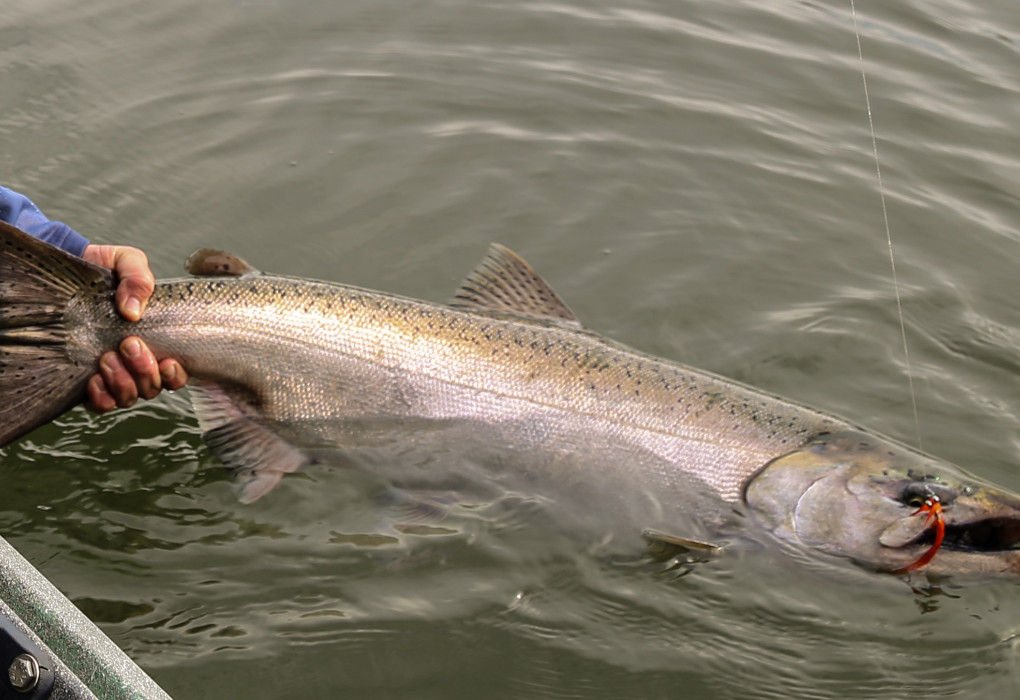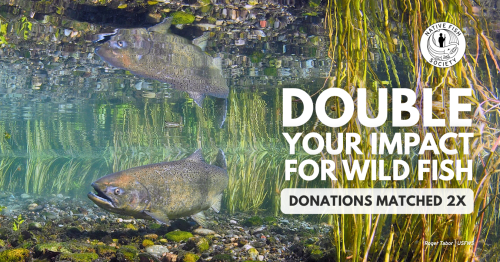Abundant wild fall Chinook salmon in the Rogue show us what’s possible
There is much to celebrate about this year’s forecast for close to a half million wild fall Chinook salmon returning to the Rogue River in Southern Oregon. At a time when we hear more about the downward trend of Pacific Northwest salmon runs, the Rogue River shines bright as an example of what true wild abundance, in modern times, can look like.
Last year, the Pacific Fisheries Management Council (PFMC) forecasted a run of 246,800 wild fall Chinook salmon returning to the Rogue. This year, that number is nearly doubled, with a forecast of 462,800 wild fall Chinook. Forecasts for the Rogue are developed from a set of metrics, which utilize commercial salmon catches in the ocean and decades of records from beach seining by Oregon Department of Fish and Wildlife near the river’s mouth in Gold Beach to measure freshwater escapement for fall chinook, coho, late-run summer steelhead, and “half-pounder” steelhead.
By comparison, 2018 PFMC forecasts for fall Chinook salmon in nearby Pacific watersheds are 229,400 in the Sacramento (1,300 less than 2017 forecast); 358,400 in the Klamath (270,000 more than 2017 forecast); and 592,600 in the Columbia (66,400 less than 2017).
The Rogue River is an iconic and storied river in its own right, but it is important to recognize its year-after-year increase in wild chinook returns are no accident. Despite chaotic environmental conditions including drought, El Nino, and the Blob of hot water in the Pacific, wild chinook abundance in recent years is a reflection of decades of hard work and cooperation by a dedicated collection of agencies, elected representatives, Tribal Nations, non-governmental organizations, conservation interests, and commercial and recreational anglers.
There are lessons to be learned from the Rogue that can be applied across the Northwest.
First, without hesitation, one of the best lessons we can learn from the Rogue is that its fall Chinook are 99% wild salmon. Whereas, neighboring rivers have large hatchery programs that have failed to provide the abundance promised through their hatchery programs, the Rogue’s wild Chinook are self-sustaining and more resilient to the environmental changes that we are seeing today in the marine and freshwater environments. Wild salmon consistently win the survivor contest.
Second, the removal of obsolete dams in the mainstem Rogue and smaller tributary barriers by groups such as WaterWatch of Oregon, Rogue River Watershed Council, Applegate Partnership and Watershed Council, and more recently through the Rogue Basin Partnership (a collection of twenty local, regional, and national partners including NFS) has allowed fish to access important coldwater habitats. The level of focused investment in dam and barrier removal is unique to the Rogue and provides immediate benefits to fish, while paying dividends in the future as each generation of wild fish adapts to and utilizes these new habitats.
Third, proactive actions by the Oregon Department of Fish and Wildlife to engage basin wide stakeholders and develop two science-based conservation and management plans for Chinook (both spring and fall Chinook) in the Rogue have created community buy-in for fisheries that support wild fish and encourage diverse populations.
Starting in 2004, NFS’s Rogue River Steward Peter Tronquet served on a public advisory committee convened by ODFW, that included representatives of Native Fish Society, ODFW, the Army Corps of Engineers, U.S. Forest Service, Bureau of Land Management, NOAA Fisheries, and sport-fishing guides from the upper and lower river. After 25 meetings over two years, the committee had developed recommendations for a Conservation Plan for Spring Chinook, and was shortly followed by another Conservation Plan for Fall Chinook, which were formally adopted in 2007 and 2013, respectively. Included in these plans were dedicated, congressionally authorized, block storage water in Lost Creek Reservoir that among its many goals, include minimizing pre-spawn mortality among spring and fall Chinook, assist spring Chinook migration up river at critical times, minimize dewatering of juveniles, and established a cooperative relationship between ODFW and the Army Corps to ensure sufficient flows are available during redd development and egg incubation. The Plans detail measurable goals and targets for not just abundance, but age structure, run-timing, and run composition - meaning the percentage of hatchery-origin fish in the population.
Fourth, strategic investments in watershed-scale habitat restoration and dedicated instream flows for fish - lead by The Freshwater Trust, Trout Unlimited, Cow Creek Band of Umpqua Tribe of Indians, Lomakatsi, watershed councils across the basin, and a suite of dedicated partners - have combined to ensure that degraded habitats are actively restored to support wild fish. Consequently, restoring habitat across the basin will continue to help buffer the effects of poor ocean conditions down the road.
Finally, habitat protections through grassroots advocacy from NFS’s Rogue River Steward Charles Gehr and our partners at Rogue Riverkeeper have reformed harmful in-stream suction dredge mining in all essential salmon habitat in the Rogue (and the state of Oregon!). In 2017, years of effort by a diverse coalition of nonprofits, scientists, and businesses secured an important victory for wild fish and clean water in Oregon through the passage of the Suction Dredge Reform Bill - Senate Bill 3 - in total 22,000 miles of salmon and steelhead habitat were protected. In addition, the mainstem Rogue benefits from two federal Wild and Scenic River designations and the Wild Rogue Wilderness, which help ensure its waters remain cool for fish and prevent new dams from developing. Combined with the other actions across the basin, we should see this year's return of wild salmon finding plenty of high quality habitat for them to utilize.
In short, this year’s anticipated big run of wild fall Chinook on the Rogue is a great reason for us all to come together and celebrate what’s possible when many people across a watershed work for the benefit of wild salmon. And, importantly, the Rogue and it’s wild fall Chinook point toward a wild future not just for southern Oregon, but for the Pacific Northwest and the many watersheds that face similar challenges for wild fish, clean water, and the communities they support.
Even with all that is going well on the Rogue, our River Stewards and partners throughout the basin are currently working for increased habitat protections - Stay tuned for more opportunities to add your voice and support additional Wild and Scenic and Wilderness protections this year.

